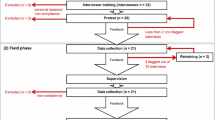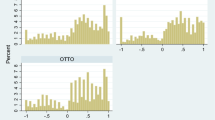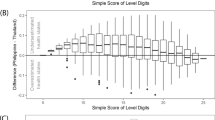Abstract
Background
National EQ-5D value sets are developed because preferences for health may vary in different populations. UK values are lower than US values for most of the 243 possible EQ-5D health states. Although similar protocols were used for data collection, analytic choices regarding how to model values from the collected data may also influence national value sets. Participants in the UK and US studies assessed the same subset of 42 EQ-5D health states using the time trade-off (TTO) method. However, different methods were used to transform negative values to a range bounded by 0 and −1, and values for all 243 health states were estimated using two different regression models. The transformation of negative values is inconsistent with expected utility theory, and the choice of which transformation method to use lacks a theoretical foundation.
Objectives
Our objectives were to assess how much of the observed difference between the UK and US EQ-5D value sets may be explained by the choice of transformation method for negative values relative to the choice of regression model and the differences between elicited TTO values in the respective national studies (datasets).
Methods
We applied both transformation methods and both regression models to each of the two datasets, resulting in eight comparable value sets. We arranged these value sets in pairs in which one source of difference (transformation method, regression model or dataset) was varied. For each of these paired value sets, we calculated the mean difference between the two matching values for each of the 243 health states. Finally, we calculated the mean utility gain for all possible transitions between pairs of EQ-5D health states within each value set and used the difference in transition scores as a measure of impact from changing transformation method, regression model or dataset.
Results
The mean absolute difference in values was 1.5 times larger when changing the transformation method than when using different datasets. The choice of transformation method had a 3.2 times larger effect on the mean health gain (transition score) than the choice of dataset. The mean health gain in the UK value set was 0.09 higher than in the US value set. Using the UK transformation method on the US dataset reduced this absolute difference to 0.02. The choice of regression model had little overall impact on the differences between the value sets.
Conclusions
Most of the observed differences between the UK and US value sets were caused by the use of different transformation methods for negative values, rather than differences between the two study populations as reflected in the datasets. Changing the regression model had little impact on the differences between the value sets.






Similar content being viewed by others
References
Szende A, Oppe M, Devlin NJ, et al., editors. EQ-5D value sets: inventory, comparative review and user guide [EuroQol Group monographs vol. 2]. Dordrecht: Springer, 2006
Drummond MF. Methods for the economic evaluation of health care programmes. 3rd rev. ed. Oxford: Oxford University Press, 2005
Dolan P, Gudex C, Kind P, et al. The time trade-off method: results from a general population study. Health Econ 1996 Mar; 5(2): 141–54
Johnson JA, Luo N, Shaw JW, et al. Valuations of EQ-5D health states: are the United States and United Kingdom different? Med Care 2005 Mar; 43(3): 221–8
Shaw JW, Johnson JA, Coons SJ. US valuation of the EQ-5D health states: development and testing of the D1 valuation model. Med Care 2005 Mar; 43(3): 203–20
Dolan P. Modeling valuations for EuroQol health states. Med Care 1997 Nov; 35(11): 1095–108
Patrick DL, Starks HE, Cain KC, et al. Measuring preferences for health states worse than death. Med Decis Making 1994 Feb; 14(1): 9–18
Tilling C, Devlin N, Tsuchiya A, et al. Protocols for time tradeoff valuations of health states worse than dead: a literature review. Med Decis Making 2010; 30(5): 610–9
Lamers LM. The transformation of utilities for health states worse than death: consequences for the estimation of EQ-5D value sets. Med Care 2007 Mar; 45(3): 238–44
Noyes K, Dick AW, Holloway RG. The implications of using US-specific EQ-5D preference weights for cost-effectiveness evaluation. Med Decis Making 2007; 27(3): 327–34
Nan L, Johnson JA, Shaw JW, et al. A comparison of EQ-5D index scores derived from the US and UK population-based scoring functions. Med Decis Making 2007; 27(3): 321–6
Noyes K, Dick AW, Holloway RG. Pramipexole v. levodopa as initial treatment for Parkinson’s disease: a randomized clinical-economic trial. Med Decis Making 2004; 24(5): 472–85
Norman R, Cronin P, Viney R, et al. International comparisons in valuing EQ-5D health states: a review and analysis. Value Health 2009; 12(8): 1194–200
Knies S, Evers SM, Candel MJ, et al. Utilities of the EQ-5D: transferable or not? Pharmacoeconomics 2009; 27(9): 767–79
Fryback DG. A US valuation of the EQ-5D. Med Care 2005 Mar; 43(3): 199–200
Devlin NJ, Tsuchiya A, Buckingham K, et al. A uniform time trade off method for states better and worse than dead: feasibility study of the “lead time” approach. Health Econ 2011; 20(3): 348–61
Craig BM, Busschbach JJ. The episodic random utility model unifies time trade-off and discrete choice approaches in health state valuation. Popul Health Metr 2009 Jan; 7: 3
Dolan P, Roberts J. Modelling valuations for EQ-5D health states: an alternative model using differences in valuations. Med Care 2002; 40(5): 442–6
Craig BM, Oppe M. From a different angle: a novel approach to health valuation. Soc Sci Med 2010; 70(2): 169–174 [online]. Available from URL: http://linkinghub.elsevier.com/retrieve/pii/S0277953609006856 [Accessed 2010 Nov 19]
Robinson A, Spencer A. Exploring challenges to TTO utilities: valuing states worse than dead. Health Econ 2006 Apr; 15(4): 393–402
Shaw JW, Pickard AS, Yu S, et al. A median model for predicting United States population-based EQ-5D health state preferences. Value Health 2010; 13(2): 278–88
Gudex C, Dolan P, Williams AH, et al. Health state valuations from the British general public, 1993. Colchester: UK Data Archive, 1995 Oct [online]. Available from URL: http://www.esds.ac.uk/doc/3444%5Cmrdoc%5CUKDA%5CUKDA_Study_3444_Information.htm [Accessed 2012 Sep 25]
Acknowledgements
This study was indirectly funded through PhD scholarships to Liv Ariane Augestad and Kim Rand-Hendriksen. The funding sources were the South-Eastern Norway Regional Health Authority and the Norwegian Research Council. The authors declare no conflicts of interest. They would like to thank Paul Kind for giving them access to the data from the UK EQ-5D valuation study. The authors also were eventually granted access to the full UK dataset via the Economic and Social Data Service of the UK Data Archive.[22]
Liv Ariane Augestad conceived the idea for the paper, developed hypotheses, performed data analyses and drafted the paper. Liv Ariane Augestad acts as a guarantor for the overall content.
Kim Rand-Hendriksen took part in conceiving the idea of the paper, took part in performing several of the analyses and commented on several versions of the paper, and approved the final version accepted for publication.
Ivar Sønbø Kristiansen discussed hypotheses, data analyses and interpretation of the results, commented on several versions of the paper and approved the final version accepted for publication.
Knut Stavem discussed hypotheses, and advised on data analyses and interpretation of the results. He commented on many versions of the paper and approved the final version accepted for publication.
Author information
Authors and Affiliations
Corresponding author
Rights and permissions
About this article
Cite this article
Augestad, L.A., Rand-Hendriksen, K., Kristiansen, I.S. et al. Impact of Transformation of Negative Values and Regression Models on Differences Between the UK and US EQ-5D Time Trade-Off Value Sets. PharmacoEconomics 30, 1203–1214 (2012). https://doi.org/10.2165/11595420-000000000-00000
Published:
Issue Date:
DOI: https://doi.org/10.2165/11595420-000000000-00000




